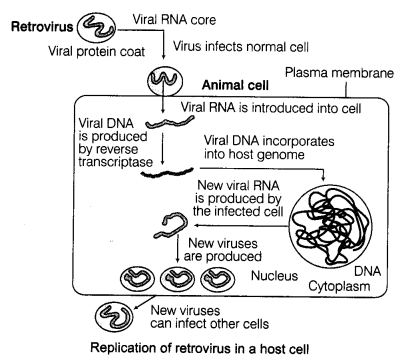CBSE Sample Papers for Class 12 Biology Set-1
Class 12thCBSE Sample Papers for Class 12 Biology Set-1
CBSE Sample Papers for Class 12 Biology Set 1 with Solutions
Time : 3 Hours
Maximum Marks : 70
General Instructions:
- All questions are compulsory.
- The question paper has five sections and 33 questions. All questions are compulsory.
- Section-A has 16 questions of 1 mark each; Section-B has 5 questions of 2 marks each; Section-C has 7 questions of 3 marks each; Section-D has 2 case-based questions of 4 marks each; and Section-E has 3 questions of 5 marks each.
- There is no overall choice. However, internal choices have been provided
in some questions.
A student has to attempt only one of the alternatives in such questions. - Wherever necessary, neat and properly labelled diagrams should be drawn.
Section A
Question 1.
Remnants of nucellus are persistent during seed development
in
(a) pea
(b) groundnut
(c) wheat
(d) black pepper
Answer:
(d) black pepper
Question 2.
The wall layer of microsporangium which nourishes the pollen
grain is
(a) epidermis
(b) endothecium
(c) middle layers
(d)
tapetum
Answer:
(d) tapetum
Question 3.
A short piece of DNA, having 20 base pairs, was analysed to
find the number of nucleotide bases in each of the polynucleotide strands. Some
of the results are shown in the table.
| Number of nucleotide bases | ||||
| Adenine | Cytosine | Guanine | Thymine | |
| Strand 1 | 4 | 4 | ||
| Strand 2 | ||||
How many nucleotides containing Adenine were present in strand 2?
(a)
2
(b) 4
(c) 5
(d) 7
Answer:
(d) 7
Question 4.
In a certain species of insects, some have 13 chromosomes, and
the others have 14 chromosomes. The 13 and 14 chromosome bearing organisms
are
(a) males and females, respectively
(b) females and males,
respectively
(c) all males
(d) all females
Answer:
(a) males and
females, respectively
Question 5.
At a particular locus, the frequency of allele A is 0.8 and
that of allele a is 0.2. What would be the frequency of heterozygotes in a
random mating population at equilibrium?
(a) 0.32
(b) 0.16
(c) 0.24
(d) 0.48
Answer:
(a) 0.32
Question 6.
Variations caused due to mutations are
(a) random and
directionless
(b) random and directional
(c) random and small
(d)
random, small and directional
Answer:
(a) random and directionless
Question 7.
What is the smallest part of a DNA molecule that can be
changed by a point mutation?
(a) Oligonucleotide
(b) Codon
(c) Gene
(d) Nucleotide
Answer:
(d) Nucleotide
Question 8.
What should be the genotype of the indicated member?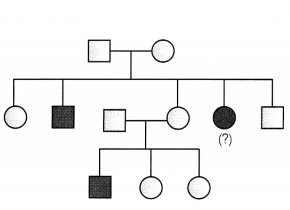
(a) AA
(b) Aa
(c) XY
(d) aa
Answer:
(d) aa
Question 9.
A patient was advised to have a kidney transplant. To suppress
the immune reaction, the doctor would administer him
(a) statins produced
from Monascus purpureus
(b) statins produced from Streptococcus
thermophilus
(c) cyclosporin-A produced from Trichoderma polysporum
(d)
cyclosporin-A produced from Clostridium butylicum
Answer:
(c)
cyclosporin-A produced from Trichoderma polysporum
Question 10.
Identify the activity of endonuclease and exonuclease in the
given image.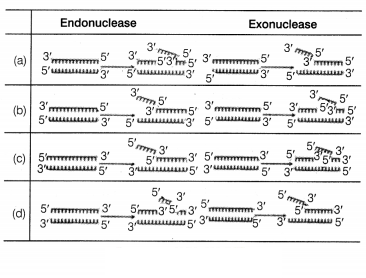
Answer:
(d)
Question 11.
The main objective of production of pest resistant GM crops
is to
(a) encourage eco-friendly pesticides
(b) reduce pesticide
accumulation in food chain
(c) eliminate pests from the field without the c
use of manual labour
(d) retain maximum nutritional content in the crop that
would be otherwise consumed by pest
Answer:
(b) reduce pesticide
accumulation in food chain
Question 12.
Observe the contents 1,2,3 and 4 of soil samples A,B and C
shown in the graph. If the temperature and soil moisture of all soil samples are
identical, which soil sample(s) will show faster decomposition?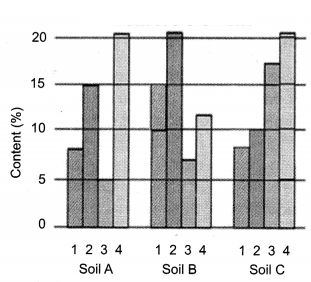
1 indicates lignin content, 2 indicates chitin, 3 indicates nitrogen content and
4 indicates sugar content.
(a) Soil sample A
(b) Soil sample B
(c) Soil
samples A and B both
(d) Soil sample C
Answer:
(d) Soil sample C
Question Nos. 13 to 16 consist of two statements – Assertion (A) and Reason
(R). Answer these questions selecting the appropriate option given below:
(a)
Both A and R are true and R is the correct explanation of A
(b) Both A and R
are true and R is not the correct explanation of A
(c) A is true, but R is
false
(d) A is false, but R is true
Question 13.
Assertion (A) : Primary endosperm nucleus is diploid.
Reason (R) : It is the product of double fertilisation.
Answer:
(d) A is
false, but R is true. A can be corrected as Primary endosperm nucleus formed by
the fusion of two polar nuclei and one male nucleus, so it is triploid (3n).
Question 14.
Assertion (A) : Ribosomal RNA is synthesised in the nucleus
of the cell.
Reason (R) : It is translated with the enzyme RNA
polymerase-III.
Answer:
(c) A is true, but R is false. R can be corrected
as rRNA transcribed by RNA polymerase-l.
Question 15.
Assertion (A) : Smoking can raise blood pressure and increase
heart rate.
Reason (R) : Nicotine stimulates adrenal glands to release
adrenaline and nor-adrenaline into the blood circulation, both of which raise
blood pressure and increase heart rate.
Answer:
(a) Both A and R are true
and R is the correct explanation of A.
Question 16.
Assertion (A) : PCR is a powerful technique to identify
genetic disorders.
Reason (R) : PCR can detect mutations in low amounts of
DNA.
Answer:
(a) Both A and R are true and R is the correct explanation of
A.
Section B
Question 17.
Explain the process of hormonal regulation of
spermatogenesis.
Answer:
Spermatogenesis starts at the age of puberty due
to significant increase in the secretion of Gonadotropin Releasing Hormone
(GnRH). This is a hypothalamic hormone.
The increased levels of GnRH then act at the anterior pituitary gland and stimulate secretion of two gonadotropins – Luteinising Hormone (LH) and Follicle Stimulating Hormone (FSH).
LH acts at the Leydig cells and stimulates synthesis and secretion of androgens. Androgens, inturn, stimulate the process of spermatogenesis.
FSH acts on the Sertoli cells and stimulates secretion of some factors which help in the process of spermiogenesis.
Question 18.
The diagram below shows the sequence of amino acids in part
of a haemoglobin molecule.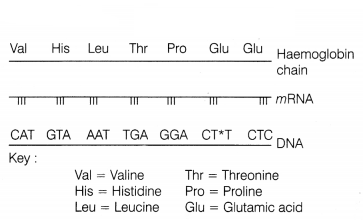
(a) If the base T* was substituted with A, how would it affect the haemoglobin
chain?
(b) Name the condition and the effects associated with the above
substitution.
Answer:
(a) CTT would become CAT which codes for valine.
Thus, valine would replace glutamic acid at that point.
(b) Sickle-cell anaemia, the mutant haemoglobin molecule undergoes
polymerisation leading to the change in the shape of the RBC from biconcave disc
to elongated sickle like structure.
The structure drops the oxygen level of
the blood. Such cell do not transport oxygen efficiently.
Question 19.
The graph given below indicates the administration of the
first (L) and second dose (M) of a vaccine. The corresponding response of the
body is indicated by X and Y. Interpret the graph and explain the reason for
such a response shown by the body.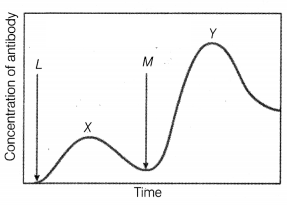
Answer:
On administration of the first dose of the vaccine
(L), the body shows a response of low intensity (X) as the immune system comes
in contact with the antigenic protein of the weakened/inactivated pathogen for
the first time. This is called primary immune response.
On subsequent encounter with the same antigenic protein in the second dose (M), the body elicits a highly intensified secondary response (Y). Because of the memory of the first contact with the antigen, the secondary immune response is faster and stronger, leading to more effective pathogen elimination in comparison to the primary immune response.
Question 20.
The image below shows the result of plating bacteria in
chromogenic medium after incorporating the gene of interest in plasmid. Some
plates had blue colonies; some plates had white colonies. A single bacterium
extracted from plate I, II, III is shown below.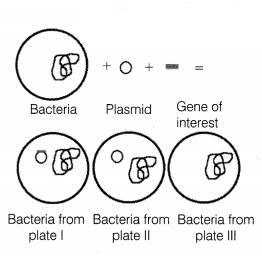
On the basis of your observations
(a) Identify the
plate(s) which is/are white. Give a reason.
(b) Identify the plate(s) which
is/are blue. Give a reason.
Answer:
(a) Plate I β-galactosidase enzyme is
responsible for blue colour. Gene is inserted in the β-galactosidase site of the
plasmid thereby causing insertional inactivation of the enzyme, so no blue
colour is made.
(b) Plate II Gene of interest not inserted in the plasmid. So, blue colour of
colonies will appear.
Plate III No plasmid
Question 21.
Biomass of a standing crop of phytoplankton is 4
kg/m2 which supports a large standing crop of zooplankton having a
biomass 11 kg/m2. This is consumed by small fishes having biomass 25
kg/m2 which are then consumed by large fishes with the biomass 37
kg/m2 . Draw an ecological pyramid indicating the biomass at each
stage and also name the trophic levels. Mention whether it is an upright or
inverted pyramid.
Or
Use the information provided in the table given below
to answer the following questions.
| Trophic Level | Net Production (KJm-2y-1) | Respiration (KJm-2y-1) |
| Top carnivore | 50 | 35 |
| Carnivores | 420 | 378 |
| Herbivores | 4490 | 4041 |
| Producers | 45000 | 40,367 |
(a) Calculate the gross primary productivity.
(b) Analyse the trend in the
net production from producers to top carnivore. Give a reason for your
observation.
Answer: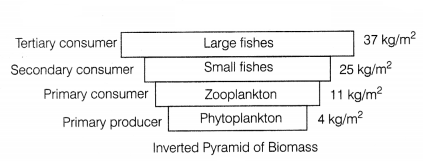
Or
(a) The GPP is the total amount of carbon compounds produced by
photosynthesis of plants in an ecosystem in a given period of time.
GPP = NPP
+ R
∴ GPP = 45,000 + 40,367
= 85367 kgm-2y-1
(b) Net production is gradually reducing as we move from producers to consumers due to heat loss/respiration/10% law.
Section C
Question 22.
The figure given below shows 3 sperms A, B and C.
(a)
Which one of the three sperms will gain entry into the ovum?
(b) Describe the
associated changes induced by it on P and Q.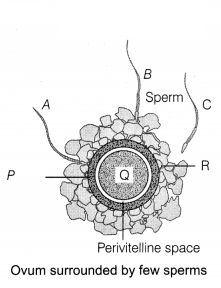
Answer:
(a) Sperm A
(b) In the figure given, Sperm A has come in contact with the zona pellucida layer (P) of the ovum (Q), it will induce changes in the membrane that will block the entry of additional sperms (B and C). Thus, it ensures that only one sperm can fertilise the ovum.
- The secretions of the acrosome of sperm A will help it to enter into the cytoplasm of the ovum (Q) through the zona pellucida (P) and the plasma membrane, this will induce the completion of the meiotic division of the secondary oocyte (Q).
- The second meiotic division in Q being unequal will result in the formation of a second polar body and a haploid ovum. Then, the haploid nucleus of the sperm A and that of the ovum (Q) will fuse together to form a diploid zygote.
Question 23.
Explain the phases in embryonic development from the morula
stage till the establishment of pregnancy in a human female.
Answer:
The
development of embryo from fertilised ovum involves the following events
(i)
Cleavage : The mitotic division starts as the zygote (fertilised ovum) gradually
moves through the isthmus of the oviduct towards the uterus. This event results
in the formation of 2, 4, 8, 16 daughter cells called blastomeres. This process
is called cleavage.
Since, the blastomeres divide completely in humans, the cleavage process is
called holoblastic.
The embryo with 8-16 blastomeres is called a morula. But,
it is not larger than a zygote.
(ii) Blastulatlon : The morula continues to divide and transforms into
blastocyst, as it moves further into the uterus. This process of transformation
is called blastulation.
The blastomeres in the blastocyst are arranged into
an outer layer (trophoblast) and the inner group of cells (inner cell mass).
(iii) Implantation : The trophoblast layer then gets attached to the
endometrium and the inner cell mass differentiates into the embryo. After
attachment, the uterine cells divide rapidly and covers the blastocyst.
As a
result, the blastocyst becomes embedded in – the endometrium of the uterus. This
is called implantation and it leads to pregnancy (i.e. the time from conception
to birth).
Question 24.
A pregnant human female was advised to undergo MTP. It was
diagnosed that the foetus she was carrying had developed from a zygote having 45
chromosomes with only one X-chromosome.
(a) What is this condition called and
how does it arise?
(b) Why was she advised to undergo MTP?
Answer:
(a)
The embryo has Turner’s syndrome due to aneuploidy of the sex chromosome. Such a
disorder is caused due to the absence of one of the X- chromosomes, i.e. 45 with
XO.
(b) She was advised MTP as the child will have the following problems
- rudimentary ovaries
- poorly developed breasts
- lack of other secondary sexual characters
- delayed or no onset of the menstrual cycle and infertile. (Any two)
Question 25.
The graphs below show three types of natural selection. The
shaded areas marked with arrows show the individuals in the population which are
not selected. The dotted vertical lines show the statistical means.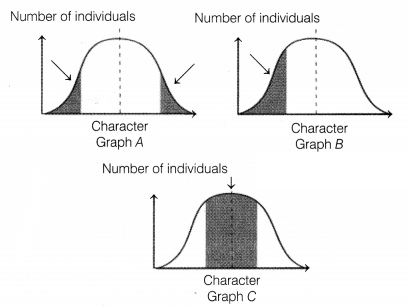
(a) What names are given to the types of selection shown in graphs A, B and
C?
(b) After the selection has operated for several generations in the above
populations indicated as graph A, B and C, graphically illustrate the probable
results.
Answer:
(a) A-stabilising; B-directional; C-disruptive;
(b) Graph A – Stabilising
Graph B – Directional
Graph C –
Disruptive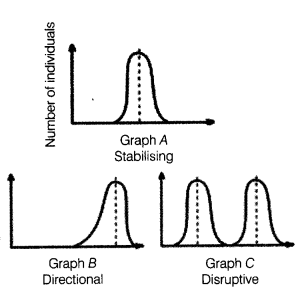
- Stabilising selection meaning a non-extreme trait is favoured instead of one of the two extremetraits.
- Directional selection mean that an extreme phenotype (character or traits) is favoured over other phenotypes and this causes the allele frequency to shify over time in favour of the extreme phenotype.
- Disruptive selection favours both extreme traits in a population.
Question 26.
The aeration tank of a sewage treatment plant is not
functioning properly. Explain in detail the impact of this on the treatment of
sewage and BOD of the effluent.
Answer:
- It will adversely affect the secondary treatment or biological treatment of sewage.
- When the aeration tank is not functional, the air will not be pumped into it.
- This will not allow the vigorous growth of useful aerobic microbes into floes (masses of bacteria associated with fungal filaments to form mesh-like structures).
- Thus, the major part of the organic matter in the effluent will not be consumed by these bacteria.
- The BOD (Biochemical Oxygen Demand) of the effluent will not be reduced. BOD refers to the amount of the oxygen that would be consumed if all the organic matter in one litre of water were oxidised by bacteria.
- The greater the BOD of wastewater, more is its
polluting potential. Thus, the effluent will remain polluted with high amount of organic matter and high BOD.
Question 27.
A farmer grew 2 varieties of corn crop in fields A and B. He
grew normal corn crops in field A and GM corn crops in fields. He observed corn
borers attacked only in field A. To control it, spores of Bt were sprayed in
field A.
(a) Name the gene in the spores responsible for the control of this
pest.
(b) What effect will the spores of Bt have on the insect pest?
(c)
How has field B developed resistance against this pest?
Or
Lipoprotein
Lipase Deficiency (LPLD) is a igenetic disorder in which a person has a
defective gene for lipase. This leads to high triglycerides, stomach pain, fat
deposits under the skin. It may eventually affect the liver, pancreas and may
also cause diabetes. The disorder occurs if a child acquires defective genes
from both parents (autosomal recessive). ERT (Enzyme Replacement Treatment) is
one of the treatments offered to patients with LPLD.
(a) (i) What procedure
is followed in ERT?
(ii) What could be one possible drawback of ERT?
(b)
How can LPLD be treated using biotechnology? Elaborate.
Answer:
(a) cry l
Ab
(b) The spores of Bt contain crystalline toxin which is inactive; for this crystalline toxin protein to become active it needs alkaline pH, which is present in insect gut. The gut lining is broken down/midgut epithelial cells become porous/swollen/cell lysis.
(c) The Bf-toxin gene is cloned and inserted into the plant genome by
recombinant DNA technology. These Genetically Modified (GM) plants express the
Bf-toxin genes and become pest-resistant in field B.
Or
(a) (i) Functional
enzyme lipase is given to the patient by injection.
(ii) This procedure is
not completely curative.
(b)
- The disease can be treated by using gene therapy.
- Gene therapy is a collection of methods that allows correction of a gene defect that has been diagnosed in a child/embryo.
- Here, genes are inserted into a person’s cells and tissues to treat a disease. Correction of a genetic defect involves delivery of a normal gene into the individual or embryo to take over the function of and compensate for the non-functional gene.
Question 28.
Give three reasons as to why the prokaryotes are not given
any figures for their diversity by the ecologists.
Answer:
Prokaryotic
organisms diversity is not given any figures by ecologist because of following
reasons
- Classification and identification of vast diversity of microbes is very difficult and cannot be efficiently done with use of currently available methods.
- For many microorganisms, it is difficult to culture them under laboratory condition.
- According to current biochemical and molecular techniques, it is estimated that microbes diversity can range in billions with microbes inhabiting diverse habitat on earth, with enormous diversity present in air, water and soil. Hence, more advanced molecular and biochemical techniques are needed to classify and identify this enormous diversity of microbes.
Section D
Q. Nos. 29 and 30 are case-based questions. Each question has 3 subparts with internal choice in one subpart.
Question 29.
The structure below shows pUC18 which is similar to pBR322 in
its function. However, they differ in some of their restriction sites and number
of ori. The ori number for pBR322 is approximately 20.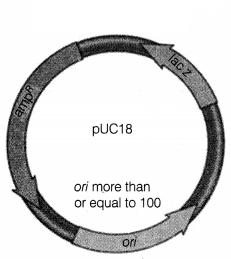
(a) How are pUC18 and pBR322 used in biotechnological
studies?
Or
What will be the impact if ori in the above structure gets
damaged?
(b) The lac z gene has many recognition sites. Study the segment of
DNA given below and answer the questions
5’… ATC GTA AAG CTT CAT…3’
3’…
TAG CAT TTC GAA GTA…5’
(i) Applying your knowledge of palindrome sequences
identify and mark the possible region where the restriction enzyme X will
act.
(ii) Restriction enzyme Y was used to extract gene of interest from a
plant. This gene needs to be inserted in the given DNA segment which has been
treated with restriction enzyme X. Will there be a successful recombination?
Explain with a reason.
(c) Which one of the two (pUC18 and pBR322) would you
prefer for biotechnological studies? Justify.
Answer:
(a) Plasmids which
can be used to insert the gene of interest from a desired organism into a host/
they act as vectors to transfer gene of interest into the host.
Or
ori
(Origin of replication) – No replication will take – place resulting in no
copies of linked DNA.
(b) (i) 5’… ATC GTA/AAG CTT /CAT.. .3’
3’… TAG CAT/TTC GAA /GTA..
.5’
Or
5’… AAG CTT …3’
3’…TTCGAA…5”
(ii) No, as the restriction enzymes need to be the same which cut the DNA of the plasmid and the gene of interest from the plant.
(c) pUC18 as it has a higher copyrate.
Question 30.
Observe the graph given below.
The graph represents
inter-specific interaction between two species of paramecia competing for the
same resource in a culture medium. Paramecium caudatum and Paramecium aurelia
were grown in separate cultures as well as in mixed cultures. It was found that
each species grew in numbers according to the logistic equation.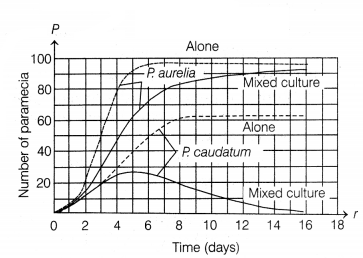
(a) Which species is competitively superior? Support it with the data provided
in the graph.
(b) State the underlying principle for the above result and
name the scientist associated with this principle.
(c) Explain the mechanism
in which two or more species competing with each other can coexist.
Or
Graphs A and B shown below depict interaction of two species. Which graph
indicates mutualism? Give reason.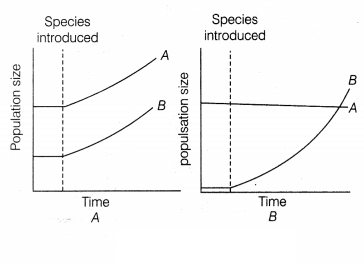
Answer:
(a) P. aurelia species is competitively superior P. aurelia grows in
numbers more quickly than P. caudatum and shows more individuals in the same
volume of culture/100 Paramecium aurelia in 6 days whereas 60 P. caudatum in 8
days.
(b) Competitive exclusion principle’ which states that two closely related species competing for the same resources cannot coexist indefinitely and the competitively inferior one will be eliminated. G.F. Gause is associated with it.
(c) One such mechanism is ‘resource partitioning’. If two species compete for
the same resource, they could avoid competition by choosing different times for
feeding or different foraging patterns, to avoid competition and coexist due to
behavioural differences in their foraging activities.
Or
Graph A indicates
mutualism. As both species grow simultaneously.
Section E
Question 31.
Placed below are case studies of some couples who were not
able to have kids. These couples are not ready for adoption or taking gametes
from donors. After thoroughly examining the cases, which assisted reproductive
technology will you suggest to these couples as a medical expert? Explain
briefly with justification of each case.
| Couples | Test Reports of Female Partner | Test Reports of Male Partner |
| Couple 1 | Normal reports | Normal sperms in testes, missing connection in epididymis and vas deferens |
| Couple 2 | Blockage in the Fallopian tube | Normal reports |
| Couple 3 | Normal reports | Poor semen parameters in terms of count, motility and morphology |
| Couple 4 | Low ovarian reserve | Normal reports |
| Couple 5 | Sterilisation in male | Morphologically abnormal sperms |
Or
Given below are certain situations. Analyse the situation and suggest
the name of suitable contraceptive device along with mode of action.
| Situation | Requirement of Contraceptive for | Name of Contraceptive Device | Mode of Action |
| 1 | Blocking the entry of sperms through cervix | ||
| 2 | Spacing between children | ||
| 3 | Effective emergency contraceptive | ||
| 4 | Terminal method to prevent any more pregnancy in female | ||
| 5 | Sterilisation in male |
Answer:
Couple 1 Normal reports of female, normal sperms in testes,
missing connection in epididymis and vas deferens in male.
Assisted Reproductive Technology
Semen will be devoid of sperms in this
case. So, In Vitro Fertilisation (IVF) by collecting the sperms from epididymis,
followed by ZIFT or IUT (Test tube baby) is suggested. ZIFT is transfer of
zygote or early embryo upto 8 blastomeres in Fallopian tube and IUT refers to
transfer of embryos with more than 8 blastomeres in uterus.
Couple 2 Blockage in the Fallopian tube in the female, normal reports of male.
Assisted Reproductive Technology Blockage of Fallopian tube will not allow transfer of sperms to the site of fertilisation. In Vitro Fertilization (IVF) followed by IUT (Test tube baby). It would involve transfer of embryo with more than 8 blastomeres in uterus.
Couple 3 Normal reports of female, poor semen parameters in terms of count, motility and morphology in male partner.
Assisted Reproductive Technology Intracytoplasmic Sperm Injection (ICSI) in which sperm is directly injected into the ovum. Artificial insemination procedure is used mainly when sperms have poor characteristic or low sperm count.
Couple 4 Low ovarian reserve in female, normal reports in male.
Assisted Reproductive Technology
In Vitro Fertilisation (IVF) by selection
of normal blastocysts from ovary followed by Zygote Intra-Fallopian Transfer
(ZIFT) involving transfer of zygote or early embryos upto 8 blastomeres or
transfer of embryo with more than 8 blastomeres in the uterus (by IUT).
Couple 5 Poor ovarian reserve in female, morphologically abnormal sperms in male partner.
Assisted Reproductive Technology ICSI Intra Cytoplasmic Sperm Injection in
which selected normal sperms will be injected into the selected blastocyst.
Intra Cytoplasmic Sperm Injection (ICSI) procedure is used mainly when sperms
have poor characteristic or low sperm count.
Or
| Situation | Requirement of Contraceptive for | Name of Contraceptive Device | Mode of Action |
| 1. | Blocking the entry of sperms through cervix | Diaphragms/cervical caps/ vaults | Cover the cervix during coitus. |
| 2. | Spacing between children | Cu or hormone releasing lUDs such as Cu T/Cu7/ Multiload 375/Progestasert/ LNG 20 | Cu ions from Cu containing lUDs increase phagocytosis of sperms within uterus, suppress sperm motility and fertilising capacity/ hormone releasing lUDs make uterus unsuitable for implantation. |
| 3. | Effective emergency contraceptive | Pills containing progestogens or progestogenoestrogen combination or IUDs within 72 hours of coitus. | Pills inhibit ovulation and implantation as well as alter the quality of cervical mucus to prevent the entry of sperms/IUDs – Cu ions increase phagocytosis of sperms within uterus, suppoess sperm rnotihty and fertilising capacity/hormone releasing IIJDs make uterus unsuitable for implantation. |
| 4. | Terminal method to prevent any more pregnancy in female | Tubectomy | Block gamete transport and prevent conception. |
| 5. | Sterilisation in male | Vasectomy | Blocks sperm transport. |
Question 32.
Given below is a stretch of DNA showing the coding strand of
a structural gene of a transcription unit?
5-ATG ACC GTA TTT TCT GTA GTG CCC
GTA CTT CAG GCA TAA—3’
(a) Write the corresponding template strand and the
raRNA strand that will be transcribed, along with its polarity.
(b) If GUA of
the transcribed mRNA is an intron, depict the sequence involved in the formation
of mRNA /the mature processed hnRNA strand.
(i) In a bacterium
(ii) In
humans
(c) Upon translation, how many amino acids will the resulting
polypeptide have? Justify.
Or
In shorthorn cattle, the coat colours red or
wh,ite are controlled by a single pair of alldles. A calf which receives the
allele for red coat from its mother and the allele for white coat from its
father is called a ‘roan’.
It has an equal number of red and white hairs in
its coat.
(a) Is this an example of codominance or of incomplete
dominance?
(b) Give a reason for your answer.
(c) With the help of genetic
cross explain what will be the consequent phenotype of the calf when
(i) red
is dominant over white
(ii) red is incompletely dominant.
Answer:
5’—ATG ACC GTA ITT TCT GTA GTG CCC GTA CTT CAG GCATAA—3’= Coding
(a) 3 —TAC
TGG CAT AAA AGA CAT CAC GGG CAT GAA GTC CGT ATT—5’= Template
mRNA 5’—AUG ACC
GUA UUU UCU GUA GUG CCC GUA CUU CAG GCA UAA—3’
(b) (i) In a bacterium
5’—AUG ACC GUA UUU UCU GUA GUG CCC GUA CUU CAG GCA
UAA—3’ [1]
(ii) In humans
5’—mGpppAUG ACC UUU UCU GUG CCC CUU CAG GCA UAA-
Poly A tail—3’ [1]
(c) 9 amino acids in the polypeptide because UAA is stop/terminator codon and
does not code for any amino acid.
Or
(a) Codominance
(b) Codominance is a condition in which two different
alleles for a
genetic trait are expressed. Individuals receive one version of a gene, called
an allele, from each parent.
(c) (i) If pure breeding red coated cattles are represented as ‘RFT and pure
breeding white coated as ‘rr’. If red is dominant over white. A cross between
‘RR’ and ‘rr’ would produce red coated cattles (RR) and white coated cattle (rr)
in the ratio of 3 : 1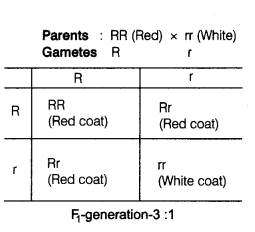
(ii) If the red and white coated cattles produce pink colour on a cross then, they exhibit incomplete dominance in the inheritance of coat colour due to which they produce pink coloured coat upon hybridisation.
If pure breeding red coated cattles are represented as ‘RR’ and pure breeding white coated as ‘rr’, then the pink coated cattles are ‘Rr’.
A cross between ‘RR’ and ‘rr’ would produce pink coated cattles (Rr) and
white coated cattle (rr) in the ratio of 1 : 2 : 1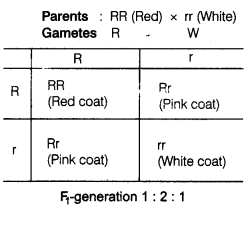
Question 33.
Explain the role of primary and secondary Lymphoid organs
with the help of suitable examples.
Or
With the help of a flowchart
illustrate how an infected animal cell can survive while viruses are being
replicated or released.
Answer:
Lymphoid organs These are the organs where
lymphocytes originate, proliferate and get matured. They can be categorised
as
1. Primary Lymphoid Organs
In primary lymphoid organs, immature
lymphocytes differentiate to mature antigen sensitive lymphocytes. After
maturation, lymphocytes migrate to secondary lymphoid organs.
The two primary lymphoid organs are as follows
(i) Bone Marrow It is the
main lymphoid organ where all the blood cells including lymphocytes are
produced. It is the major site of B-lymphocytes development and maturation.
(ii) Thymus It is a lobed organ, located near the heart and beneath the breast bone. It is large at the time of birth, but with age, the size keeps on reducing and becomes very small on attaining puberty. Growth and maturation of T-lymphocytes takes place here.
Both bone marrow and thymus provide micro-environments for the development and maturation of T-lymphocytes.
Bursa of fabricus is the primary lymphoid organ in birds that is considered equivalent to mammal’s bone marrow.
2. Secondary Lymphoid Organs
These organs provide the sites for the
interaction of lymphocytes with the antigen, which then proliferate to become
effector cells.
The secondary lymphoid organs are as follows
1. Spleen It is a large
bean-shaped organ containing lymphocytes, phagocytes and large number of
erythrocytes. It filtres the blood by trapping blood-borne microorganisms.
2. Lymph Nodes These are small solid structures located at different points along the lymphatic system. Their function is to trap the microorganisms or other antigens that enter the lymph and tissue fluid. The trapped antigens in the lymph nodes are responsible for the activation of lymphocytes present there and cause the immune response.
Peyer’s patches of small intestine, tonsils and appendix are also considered as secondary lymphoid organs.
3. Mucosal Associated Lymphoid Tissue (MALT) It is
located within the
lining of major tracts in the body like respiratory, digestive, urogenital
tracts. MALT constitutes about 50% of the lymphoid tissue in human body.
Or
In the figure given below infected cell can survive while viruses are
being replicated and released.